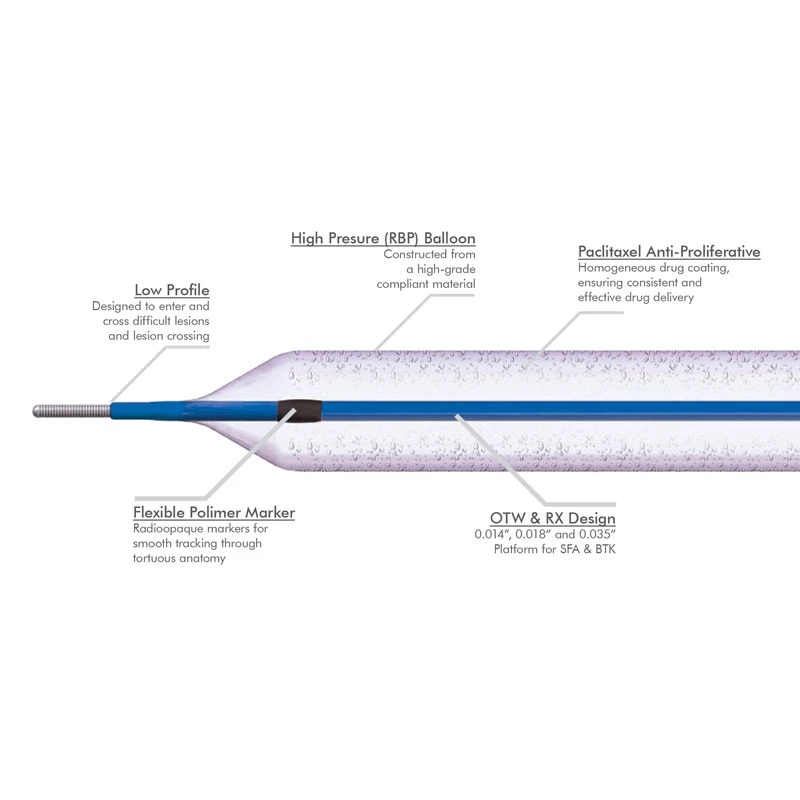Answers of Drug Eluting Coronary Balloon Catheter EXTENDER PTCA Drug Eluting Coronary Balloon Catheter
Illness and prevalence about disease
Coronary artery disease is a narrowing or blockage of your coronary arteries usually caused by the buildup of fatty material called plaque. Coronary artery disease is also called coronary heart disease, ischemic heart disease and heart disease.
Coronary arteries are the blood vessels that supply oxygen-rich blood to your heart muscle to keep it pumping. The coronary arteries are directly on top of your heart muscle. You have four main coronary arteries:
- The right coronary artery.
- The left coronary artery.
- The left anterior descending artery.
- The left circumflex artery.
Coronary heart disease is the most common type of heart disease, killing 382,820 people in 2020. About 20.1 million adults age 20 and older have CAD (about 7.2%). In 2020, about 2 in 10 deaths from CAD happen in adults less than 65 years old.
Causes and symptoms of disease
Causes
Coronary artery disease starts when fats, cholesterols and other substances collect on the inner walls of the heart arteries. This condition is called atherosclerosis. The buildup is called plaque. Plaque can cause the arteries to narrow, blocking blood flow. The plaque can also burst, leading to a blood clot.
Besides high cholesterol, damage to the coronary arteries may be caused by:
- Diabetes or insulin resistance
- High blood pressure
- Not getting enough exercise (sedentary lifestyle)
- Smoking or tobacco use
Symptoms
Symptoms may go unrecognized at first, or they may only occur when the heart is beating hard like during exercise. As the coronary arteries continue to narrow, less and less blood gets to the heart, and symptoms can become more severe or frequent.
Coronary artery disease signs and symptoms can include:
- Chest pain (angina) : You may feel pressure or tightness in your chest. Some people say it feels like someone is standing on their chest. The chest pain usually occurs on the middle or left side of the chest. Activity or strong emotions can trigger angina. The pain usually goes away within minutes after the triggering event ends. In some people, especially women, the pain may be brief or sharp and felt in the neck, arm, or back.
- Shortness of breath : You may feel like you can not catch your breath.
- Fatigue : If the heart can not pump enough blood to meet your body's needs, you may feel unusually tired.
- Heart attack : A completely blocked coronary artery will cause a heart attack. The classic signs and symptoms of a heart attack include crushing chest pain or pressure, shoulder or arm pain, shortness of breath, and sweating. Women may have less typical symptoms, such as neck or jaw pain, nausea, and fatigue. Some heart attacks don not cause any noticeable signs or symptoms.
What is features of Drug Eluting Coronary Balloon Catheter
The Extender is a drug-eluting balloon dilatation catheter designed for percutaneous transluminal coronary angioplasty (PTCA) and has been optimized for the treatment of patients with coronary arterial disease.
Extender A Drug-Eluting PTCA Balloon Catheter is used to treat coronary vessels with a balloon structure that releases drugs at the tip.
It treats interventional treatment of coronary artery disease by providing fast and effective drug delivery.
HIGH PERFORMANCE LONG-TERM EFFECTIVE CLINICAL RESULTS
How to treat and cure process
The use of drug-eluting balloons during PTCA constitutes a variation on the standard procedure, which is performed using different materials. The procedure usually starts by advancing a balloon catheter to the site of restenosis. Balloon angioplasty is performed to widen the vessel. As part of the second step of the procedure, a drug-eluting balloon is advanced to the site and then expanded. This establishes close contact between the balloon's surface and the artery wall, allowing for the drugs to be delivered directly to the artery wall.
Result and scientific studies
Six studies including a total of 1800 patients compared the differences between the drug-coated balloon and the drug-eluting stent strategies in patients with de novo small coronary artery vessel disease. The results indicated that the drug-coated balloon strategy was associated with a significant reduction in nonfatal myocardial infarction (OR 0.53, 95% CI 0.31–0.90, P=.02) compared with the drug-eluting stent strategy, while insignificant inter-strategy differences were observed in cardiac death (OR 1.56, 95% CI 0.73–3.33, P=.25), all-cause death (OR 0.56, 95% CI 0.25–1.23, P=.15), target lesion revascularization (OR 1.24, 95% CI 0.73–2.1, P=.43), and target vessel revascularization (OR 0.95, 95% CI 0.59–1.52, P=.84).
Acedemic research
- Safety and Effectiveness of the Novel Temren Atherectomy System Combined Use With Extender Drug-Eluting Balloon in Lower Extremity Arteries
- Recanalization of Totally Occluded Stent of Superficial Femoral Artery with Multiple Direct Stent Puncture
- Early outcomes of novel Temren atherectomy device combined with drug-coated balloon angioplasty for treatment of femoropopliteal lesions
- Early and midterm results of the retrograde transpopliteal approach as the first-line treatment for total occlusions of iliofemoral arteries
- Single center experience with percutaneous peripheral atherectomy with the use of C-arm scopy for the treatment of lower extremity peripheral artery disease
- Scholar search
